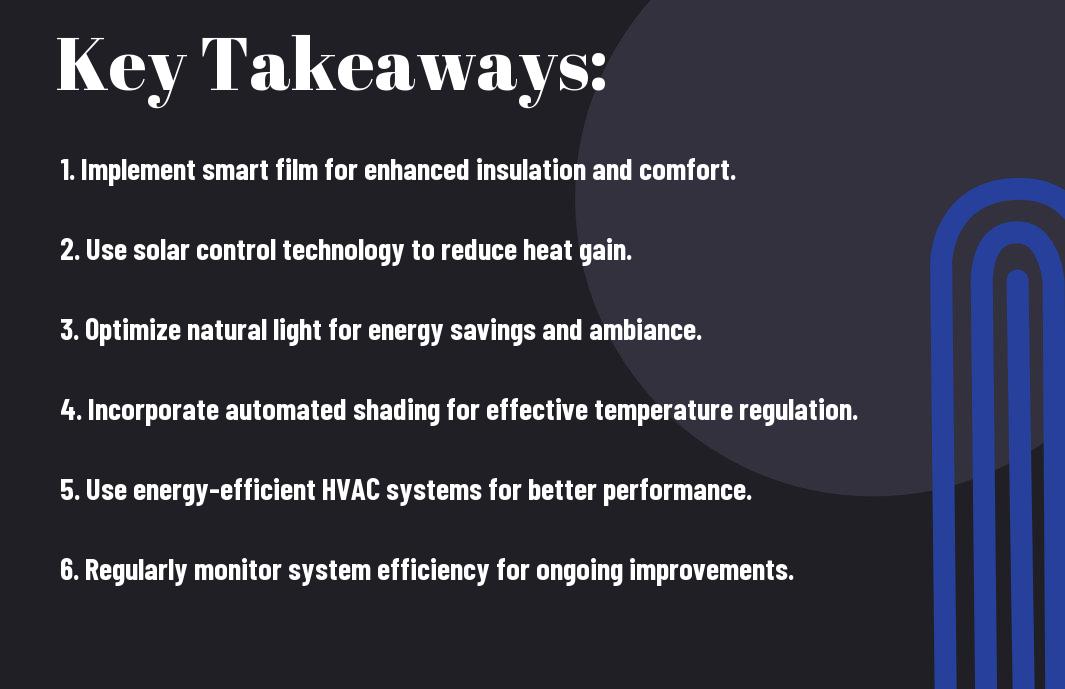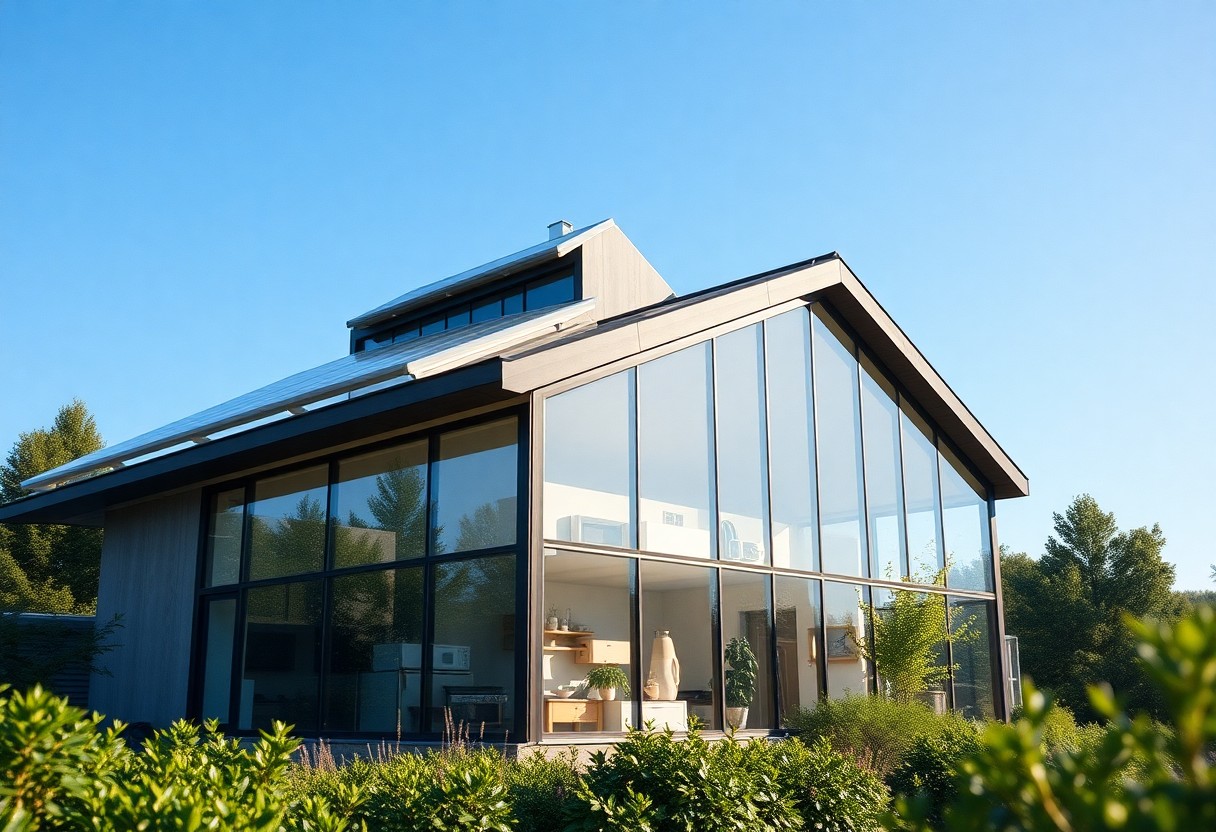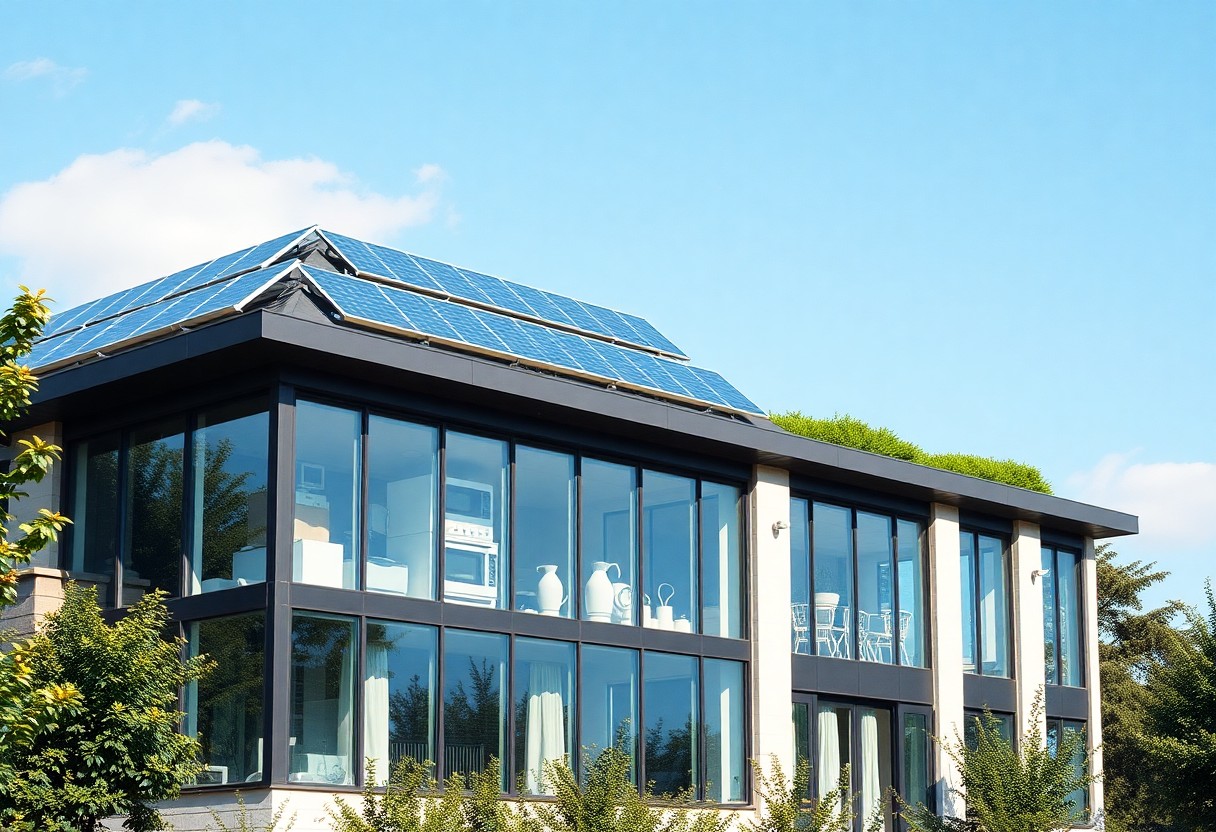As you consider ways to reduce your energy consumption, you’re likely looking for effective solutions to lower your bills and minimize your environmental impact. Your home or office in Phoenix can benefit from innovative technologies like smart window films. By applying these cutting-edge solutions, you can significantly improve energy efficiency and create a more comfortable space. In this post, you will learn how to harness the power of smart film to reduce heat gain and energy consumption, making your space more sustainable and cost-effective.
Key Takeaways:
To improve energy efficiency with Smart Film Phoenix, consider the following points:
- Implement Energy Audits to identify areas of energy inefficiency and develop strategies to address them, which can lead to significant cost savings and reduced energy consumption.
- Utilize Smart Film Technology to control heat gain and loss, reducing the need for heating and cooling systems and creating a more sustainable environment.
- Develop a Comprehensive Plan that incorporates Energy-Efficient practices and technologies, such as smart film, to minimize energy waste and maximize energy efficiency in buildings.
Benefits of Smart Film
Before investing in smart film for your Phoenix home or office, you’ll want to understand the benefits it can provide. You can enjoy increased energy efficiency, reduced energy consumption, and a more comfortable indoor climate.
Increased Energy Savings
Around the clock, smart film helps you save energy by controlling the amount of heat that enters your building, which leads to lower energy bills and increased energy savings for you.
Reduced Carbon Footprint
Energizing your efforts to go green, smart film can help you reduce your carbon footprint by minimizing the need for air conditioning and heating.
Carbon emissions are significantly decreased when you use smart film, as it reduces the strain on your HVAC system, allowing you to contribute to a more sustainable future, and you can feel good about your decision to install smart film in your Phoenix property.

Assessing Your Building
One of the first steps to improving energy efficiency in your building is to assess its current state. This involves evaluating various aspects of your building to determine areas where energy is being wasted and identifying opportunities for improvement. By doing so, you can develop a plan to optimize energy usage and reduce your energy bills.
Evaluating Current Energy Consumption
Besides analyzing your energy bills, you should also monitor your energy usage patterns to identify peak consumption periods and areas of inefficiency. This will help you understand your building’s energy profile and identify potential areas for improvement.
Identifying Areas for Improvement
Below the surface, there may be many opportunities to improve energy efficiency in your building, such as outdated lighting systems or inadequate insulation. You can identify these areas by conducting a thorough audit of your building’s systems and infrastructure.
To identify areas for improvement, you need to consider various factors, including your building’s layout, HVAC system, lighting, and insulation. You should also look for signs of energy inefficiency, such as drafts, heat loss, or excessive energy consumption. By carefully evaluating these factors, you can develop a comprehensive plan to address energy-wasting issues and optimize your building’s energy performance, which will help you achieve your energy efficiency goals and reduce your energy costs.

Choosing the Right Smart Film
Between the various options available, selecting the right smart film for your needs can be a daunting task. Many factors come into play when making this decision.
Factors to Consider
Many considerations are involved in choosing smart film, including cost, energy efficiency, and durability. You should consider:
- Energy efficiency
- Cost
- Durability
- Low-e window films
- Solar window films
- Low-e window films for cold climates
- Solar window films for hot climates
The right choice depends on your specific requirements.
Among the available options, you have several types of smart films to choose from.
Types of Smart Films Available
You have several options, including:
Any of these options can help you improve energy efficiency.
To make an informed decision, you can break down the information into the following table:
| Types of Films | Benefits |
|---|---|
| Low-e window films | Reduce heat transfer |
| Solar window films | Block UV rays |
| Smart glass films | Control light transmission |
| Ceramic window films | Provide insulation |
| Metalized window films | Reflect heat |
You can use this information to determine the best option for your needs.
Further, you can consider the specific characteristics of each type of smart film. You have several options, including:
Any of these options can help you achieve your energy efficiency goals, and you can use the following table to compare them:
| Types of Films | Benefits |
|---|---|
| Low-e window films | Reduce heat loss |
| Solar window films | Block UV rays |
| Smart glass films | Control light transmission |
| Ceramic window films | Provide insulation |
| Metalized window films | Reflect heat |
Any of these options can be a good choice, depending on your specific requirements.
Installation and Maintenance
Unlike other energy-efficient solutions, smart film installation is relatively straightforward.
With respect to installing smart film, you have two primary options: professional installation or DIY installation.
Professional Installation Options
Along with the added cost, professional installation provides a guarantee and ensures the job is done correctly, giving you peace of mind.
DIY Installation Considerations
Above all, DIY installation can be a cost-effective way to apply smart film to your windows, but it requires careful consideration of your skills and the specific product you are using.
For instance, if you decide to go with a DIY installation, you will need to ensure that your windows are thoroughly cleaned and prepared before applying the film, and that you follow the manufacturer’s instructions carefully to avoid air bubbles or other issues that can affect the film’s performance and longevity, which can impact your overall energy efficiency and savings, and ultimately, the comfort and energy efficiency of your home depend on your ability to properly install and maintain your smart film, so it’s necessary to weigh your options carefully and consider what’s best for your specific situation and needs.
Monitoring and Controlling Energy Usage
All buildings can benefit from monitoring and controlling energy usage to improve efficiency. You can achieve this by implementing smart technologies that provide insights into your energy consumption patterns.
Smart Film Integration with Building Management Systems
To effectively manage energy usage, you need to integrate smart film with your building management systems, allowing you to control and monitor your energy consumption from a single platform, making it easier for you to optimize your energy usage.
Real-Time Energy Monitoring
Between the various options available, real-time energy monitoring stands out as an effective way to track your energy consumption, enabling you to identify areas of waste and take corrective action to reduce your energy usage, which you can do by utilizing smart film solutions.
It is necessary to note that real-time energy monitoring provides you with detailed information about your energy consumption, allowing you to make informed decisions about your energy usage, and with smart film, you can control the amount of energy used by your windows, which can significantly impact your overall energy consumption, helping you to achieve your energy efficiency goals.

Cost Savings and Return on Investment
Keep in mind that installing Smart Film in Phoenix can have a significant impact on your energy efficiency, which in turn affects your cost savings and return on investment. By reducing the amount of heat that enters your building, you can lower your energy consumption and save on your utility bills.
Calculating Energy Savings
Any calculation of energy savings will depend on various factors, including the size of your building, the type of Smart Film used, and your current energy consumption. You can expect to save a significant amount on your energy bills, which will contribute to your overall cost savings.
Potential Return on Investment
Any potential return on investment will be influenced by the initial cost of installing Smart Film, as well as the ongoing energy savings you will enjoy. You can expect a substantial return on your investment, as the energy savings will add up over time.
In addition, as you consider the potential return on investment, you should also think about the long-term benefits of installing Smart Film, such as the increased comfort and productivity of your occupants, as well as the potential increase in property value. You will be able to enjoy these benefits while also saving money on your energy bills, making your investment in Smart Film a wise decision for your business or home.
Conclusion
So, you have learned about Smart Film Phoenix and its benefits. You can now improve your energy efficiency by following the 5 steps outlined. By applying these steps, you will enhance your building’s energy performance, reducing your energy consumption and costs. You will also contribute to a more sustainable environment, making your space more comfortable and eco-friendly. Your efforts will yield long-term benefits, saving you money and minimizing your carbon footprint.
FAQ
Q: What is Smart Film Phoenix and how can it improve energy efficiency in buildings?
A: Smart Film Phoenix is a innovative window film technology designed to help reduce energy consumption and improve energy efficiency in buildings. It works by applying a specialized film to existing windows, which helps to block heat, reduce glare, and minimize UV radiation. By installing Smart Film Phoenix, building owners can significantly lower their energy bills and reduce their carbon footprint, while also enhancing the comfort and productivity of occupants.
Q: What are the 5 steps to improve energy efficiency using Smart Film Phoenix?
A: The 5 steps to improve energy efficiency using Smart Film Phoenix are: (1) Conduct an energy audit to identify areas of energy inefficiency in the building; (2) Apply Smart Film Phoenix to existing windows to reduce heat transfer and minimize energy loss; (3) Integrate Smart Film Phoenix with existing building management systems to optimize energy usage; (4) Monitor and track energy consumption to identify areas for further improvement; and (5) Perform regular maintenance to ensure the longevity and effectiveness of the Smart Film Phoenix installation.
Q: How can building owners and managers measure the effectiveness of Smart Film Phoenix in improving energy efficiency?
A: Building owners and managers can measure the effectiveness of Smart Film Phoenix by tracking changes in energy consumption and costs before and after installation. This can be done by analyzing utility bills, using energy monitoring systems, and conducting regular energy audits. Additionally, the effectiveness of Smart Film Phoenix can be evaluated by assessing the impact on occupant comfort, productivity, and overall satisfaction. By monitoring these key performance indicators, building owners and managers can determine the return on investment (ROI) of Smart Film Phoenix and identify opportunities for further energy efficiency improvements.
